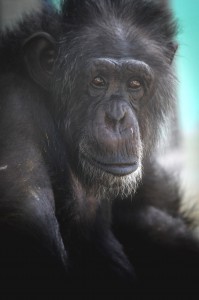By Dr. Jocelyn Bezner 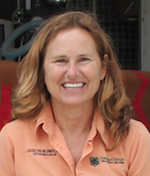
I am the senior veterinarian at Save the Chimps and have been with the organization since 2003. I received my veterinary degree from the University of Pennsylvania and practiced medicine in New York and Chicago prior to working with the chimps.
I love what I do and wouldn’t want to be anywhere else!
![]()
Help support the chimps’ veterinary care
May 2016 – Indian River Magazine Feature by L. L. Angell: By 8 most mornings at the biggest chimpanzee sanctuary in the world, the fog has burned off the moats surrounding the 12 islands — home to 254 chimpanzees. As caregivers serve breakfast, Dr. Jocelyn Bezner begins morning rounds…..Read Article
May 2016 – Sanctuary Updates: Hello! I want to apologize for not blogging for such a long time. My only excuse is that at Save the Chimps everyone works on “chimp time” so medical cases, behavioral concerns, and new rescues are the highest priorities….. Read More
April 2015 – Driving Ms. Iris: Jen Feuerstein and I have become great travelling companions as we have rescued and moved chimpanzees over the past decade. So when the call came that Iris was cleared to come to Save The Chimps, we…. Read More
November 2014 – Jambo: I am happy to be writing this blog while looking t the beautiful snow covered cap of Mt. Kenya. I is an extreme pleasure to be at the Ol Pejeta Conservancy, an extraordinary 90,000 acre wildlife preserve in central Kenya…. Read More
September 2014 – Take a chimp to lunch: Like all patients recovering from anesthesia, all chimpanzees must be monitored carefully until they are fully recovered. My job is to keep them safe and at the same time protect the veterinary team and everyone…. Read More
August 2014 – On death and dying: I’m sure I speak for all the people here at Save the Chimps when I say caring for chimpanzees is an amazing honor. Each day brings surprises, challenges and a lot of satisfaction and I wouldn’t want to be anywhere else….Read More
June 2014 – A day in the life of the vets: There is no “typical” day for a Save the Chimps veterinarian. Every day is unique and as hard as we may try to stick to a routine or schedule, the chimpanzees often have their own ideas. Mornings begin with daily rounds…. Read More.
April 2014 – Giving Meds: I was sitting at my desk this afternoon and I heard someone ask Janie, a caregiver, if she thought Roman, would like some oatmeal. She replied, “Only if it isn’t too…. Read More.
Heartfelt Medicine | Indian River Magazine

Sanctuary Updates
Hello! I want to apologize for not blogging for such a long time. My only excuse is that at Save the Chimps everyone works on “chimp time” so medical cases, behavioral concerns, and new rescues are the highest priorities. Today I thought I would share an update sent to all the departments last week. I hope you enjoy hearing about the changes as well.
Hi everyone,
Cold season is finally over. We made it without any viral outbreaks in the chimpanzees, so good job to everyone for keeping the chimps safe and healthy.
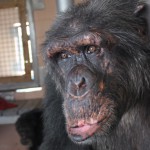 We’ve welcomed quite a few new residents and moved chimps around for psychological or medical reasons. Rebel, who suffered a neck injury and lost the use of his arms in September, has regained full strength and movement and has been reunited with his family at Doug’s building. His best friend Huey and the girls really missed him and are showering him with lots of attention. Rebel LOVES going out on the island and it’s great to see him strutting his stuff across the grass again.
We’ve welcomed quite a few new residents and moved chimps around for psychological or medical reasons. Rebel, who suffered a neck injury and lost the use of his arms in September, has regained full strength and movement and has been reunited with his family at Doug’s building. His best friend Huey and the girls really missed him and are showering him with lots of attention. Rebel LOVES going out on the island and it’s great to see him strutting his stuff across the grass again.
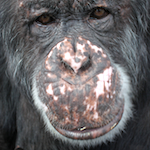 Timmy and Cheetah are both in their 40s and have been living together because they both had trouble in larger groups. It still amazes me that Dr. Noon was able to form so many compatible relationships between chimps that were raised in nurseries and never got the opportunity to learn chimp social skills from their mothers and elders. But a few, like Timmy and Cheetah, just never fit in and were often misunderstood by other chimpanzees. We’ve tried to give them more friends over the years but it turns out that Cheetah is extremely jealous of anyone who pays attention to Timmy. Recently we moved them to the Special Needs Facility and placed them on different ends of the buildings and large play yards. This way if Timmy had a new friend, Cheetah would not see it and get upset. Timmy was introduced to Joe, our newest resident from Alabama, and they are very happy together. They are both energetic and play hard while slapping, grabbing feet, and
Timmy and Cheetah are both in their 40s and have been living together because they both had trouble in larger groups. It still amazes me that Dr. Noon was able to form so many compatible relationships between chimps that were raised in nurseries and never got the opportunity to learn chimp social skills from their mothers and elders. But a few, like Timmy and Cheetah, just never fit in and were often misunderstood by other chimpanzees. We’ve tried to give them more friends over the years but it turns out that Cheetah is extremely jealous of anyone who pays attention to Timmy. Recently we moved them to the Special Needs Facility and placed them on different ends of the buildings and large play yards. This way if Timmy had a new friend, Cheetah would not see it and get upset. Timmy was introduced to Joe, our newest resident from Alabama, and they are very happy together. They are both energetic and play hard while slapping, grabbing feet, and 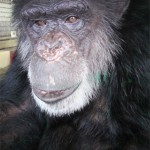 wrestling. Sometimes I separate them so Timmy, who has heart disease, will take a break. Meanwhile, Cheetah was introduced to Iris, but she yelled at him and really hurt his feelings. He wouldn’t interact with us for a full day, and anyone who knows Cheetah knows he loves to interact with people. Next, we had Millie meet Cheetah, and they got along great. Here are two chimps so damaged from their past that they didn’t know how to interact with other chimpanzees, yet they have managed to forge a special bond and groom, play, and nest together. They are now most often found on the top platform with Cheetah lounging with his feet up, and Millie sitting quietly grooming him. We will continue to update you on these two.
wrestling. Sometimes I separate them so Timmy, who has heart disease, will take a break. Meanwhile, Cheetah was introduced to Iris, but she yelled at him and really hurt his feelings. He wouldn’t interact with us for a full day, and anyone who knows Cheetah knows he loves to interact with people. Next, we had Millie meet Cheetah, and they got along great. Here are two chimps so damaged from their past that they didn’t know how to interact with other chimpanzees, yet they have managed to forge a special bond and groom, play, and nest together. They are now most often found on the top platform with Cheetah lounging with his feet up, and Millie sitting quietly grooming him. We will continue to update you on these two.
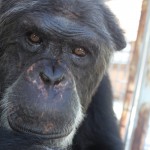 JR was moved from the Special Needs Facility to Alice’s family now that his atrial fibrillation is under control with medications. He has met Mikey, Melissa, and Tony individually, but so far Mikey and JR seem to be most compatible. Because of his heart, we have to be very careful that the chimps he is introduced to are gentle and friendly. He has enjoyed getting out on the island, though Mikey prefers to stay close to the building. Maybe with time JR will convince Mikey how much fun it is to wander a large, grassy space.
JR was moved from the Special Needs Facility to Alice’s family now that his atrial fibrillation is under control with medications. He has met Mikey, Melissa, and Tony individually, but so far Mikey and JR seem to be most compatible. Because of his heart, we have to be very careful that the chimps he is introduced to are gentle and friendly. He has enjoyed getting out on the island, though Mikey prefers to stay close to the building. Maybe with time JR will convince Mikey how much fun it is to wander a large, grassy space.
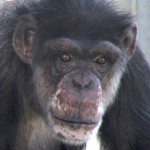 Tarzan, who retired to Save the Chimps this past March from chilly Indiana, has a family of five right now. He never is seen without his signature spoons, but Terry, Jeannie, Indie, and Cayenne don’t seem to mind. We tried introducing Liberty to the small group, but she caused too much tension between Terry and Tarzan, so we are giving Tarzan and Terry more time to bond before enlarging their group. Yesterday, Terry and Tarzan played a lot.
Tarzan, who retired to Save the Chimps this past March from chilly Indiana, has a family of five right now. He never is seen without his signature spoons, but Terry, Jeannie, Indie, and Cayenne don’t seem to mind. We tried introducing Liberty to the small group, but she caused too much tension between Terry and Tarzan, so we are giving Tarzan and Terry more time to bond before enlarging their group. Yesterday, Terry and Tarzan played a lot.
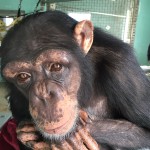 And last but not least, Lisa Marie is doing great with a mixture of new friends and old as she gets more comfortable with her family. I have no doubt that she will be fully accepted into Kiley’s family, but we will do it on Lisa Marie’s terms, not ours. She continues to charm everyone, human or chimp, who meets her.
And last but not least, Lisa Marie is doing great with a mixture of new friends and old as she gets more comfortable with her family. I have no doubt that she will be fully accepted into Kiley’s family, but we will do it on Lisa Marie’s terms, not ours. She continues to charm everyone, human or chimp, who meets her.
Driving Ms. Iris
Jen Feuerstein, our Sanctuary Director, and I have become great travelling companions as we have rescued and moved chimpanzees over the past decade. So when the call came that Iris was cleared to come to Save The Chimps, we packed up the van with medical supplies, food, blankets, and a transport box and hit the road. Jen had done most of the preliminary work prior to picking Iris up; documents, permits and the very important affidavit confirming that the Chestatee Wildlife Zoo would never obtain or exhibit another great ape. Once everything was signed, sealed and delivered, Jen and I took off on the long drive north. Jen knows that I hate to drive and she good-naturedly does the bulk of it without complaint, leaving me to navigate, read, and nap.
Moving a chimpanzee is stressful for everyone involved, chimps and humans both. Our job is to make the transfer as easy and safe as possible. Early the next morning, I assisted their veterinarian with the sedation and physical exam of Iris. She appeared to be overweight and out of shape. Her thin hair and lightly pigmented skin suggested that she hadn’t been in the sun much. Blood and fecal samples were sent to our lab and a TB test was done. Once we are finished and she was waking up in our secure transfer box, I began to relax. Jen and I say goodbye and start the long journey home, happy to have Iris safe and sound and on her way to Florida.
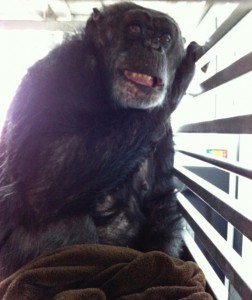 I monitored her vitals as Iris slept the first five hours of the trip. When she woke up she spent the majority of her time looking out the window but would take naps in her soft nest of blankets, totally ignoring the fruit and treats we offered. We tried our best to talk chimp, but she couldn’t have cared less about either one of us. So we left her alone with her thoughts, wondering how it must be for her to being riding down a highway. She seemed very relaxed, but withdrawn; she never uttered a sound during the 10 hour drive.
I monitored her vitals as Iris slept the first five hours of the trip. When she woke up she spent the majority of her time looking out the window but would take naps in her soft nest of blankets, totally ignoring the fruit and treats we offered. We tried our best to talk chimp, but she couldn’t have cared less about either one of us. So we left her alone with her thoughts, wondering how it must be for her to being riding down a highway. She seemed very relaxed, but withdrawn; she never uttered a sound during the 10 hour drive.
As we pulled into the sanctuary after nightfall, we were welcomed by a small group of caregivers and our new executive director, Molly Polidoroff, who was relieved to see us arrive safely. Iris, still silent, was wheeled into the building in the transfer box and attached to a sliding door that connects to her new indoor housing. The door was opened and Iris entered a room decorated with toys, streamers and welcome home posters. For the first time Iris came alive! But it wasn’t the decorations or getting out of the box that made her vocalize, it was another chimp! Nigida was sitting up at the window between the two cages welcoming her as well. When she saw him she began pant hooting and calling to him, excitedly climbing up to greet him. Ah, Jen Feuerstein said, that explains her silence on the trip – she’s a chimp’s chimp. A week later Iris met Abdul and they became inseparable friends – and she hasn’t been quiet since! Best of all, Iris will be going onto an island with Pam and Abdul tomorrow so make sure you look for the Iris updates on our website!!
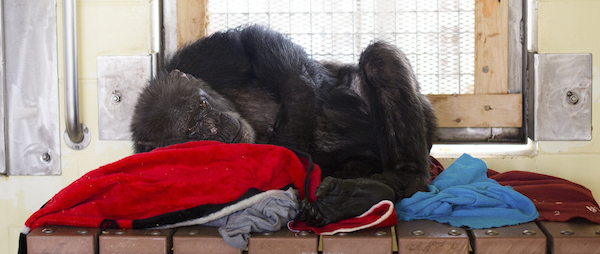
Jambo,
I am happy to be writing this blog while looking at the beautiful snow covered cap of Mt Kenya. It is an extreme pleasure to be at the Ol Pejeta Conservancy, an extraordinary 90,000 acre wildlife preserve in central Kenya that works to protect such important species as the black rhino, Grevy’s zebra and Jackson’s hartebeest. Three of the remaining 6 Northern White Rhino in the world live at Ol Pejeta. Critical research of tick born diseases, conservation, management of domestic cattle with wildlife, zoonotic disease and behavioral studies are some of scientific projects I’ve learned about. I am staying at the research center and meal times provide interesting conversations as I listen to all the visiting academics discuss their work.
Ol Pejeta is also home to the Sweet Waters Chimpanzee Sanctuary that cares for 39 chimpanzees rescued mainly from Birundi, southern Sudan and Nigeria. Their stories, like many of the chimps in Florida, are horrific. At the small but informative museum you see the actual cages and collars the chimps were rescued from and it’s hard to understand how we humans can be so cruel. The sanctuary consists of 2 families of chimps. Both groups have large savanna forests surrounded by electrical fences and separated by the Ewaso Nyiro River. Dr. Carole Noon helped design the chimp buildings and they are similar to the ones in Florida. All the caregivers at the sanctuary fondly remember Dr. Noon.
 The chimps here are much different looking than the chimps in Florida. They are smaller with finer features. Since there are 4 subspecies of chimps, I suspect they are from a different part of Africa than the chimps in Florida. The Sweetwaters Sanctuary, like Save The Chimps, had a few “oops babies” over the years. Mwanso has two little girls, Angela and Ajabu. Like Gabe, Mia and Leo, they are adorable and it was a lot of fun to watch their shenanigans. But all true sanctuaries strive to prevent reproduction. Sweetwaters uses an implantable hormone for birth control. Unfortunately, there are times when the implant does not last as long as it should or has been inadvertently removed by the chimp.
The chimps here are much different looking than the chimps in Florida. They are smaller with finer features. Since there are 4 subspecies of chimps, I suspect they are from a different part of Africa than the chimps in Florida. The Sweetwaters Sanctuary, like Save The Chimps, had a few “oops babies” over the years. Mwanso has two little girls, Angela and Ajabu. Like Gabe, Mia and Leo, they are adorable and it was a lot of fun to watch their shenanigans. But all true sanctuaries strive to prevent reproduction. Sweetwaters uses an implantable hormone for birth control. Unfortunately, there are times when the implant does not last as long as it should or has been inadvertently removed by the chimp.
I was invited to Africa to do vasectomies with Dr. George Paul, a Kenyan wildlife vet stationed at Ol Pejeta. He is an excellent veterinarian and it’s a wonderful experience working with him. I am happy to report that all the surgeries and health checks went very well and the staff is as helpful and dedicated as the caregivers as Save the Chimps.
As a bonus, I am now spending a few days accompanying Dr. Paul on his wildlife calls. We examined sick zebra, learned about the rhino populations at the conservancy and are scheduled tomorrow to take blood on over 100 Boran cattle. But no story of Africa is complete without describing the wonderful Kenyans themselves. They are truly a lovely and welcoming people with a great sense of humor and a joy of life that is infectious!
Many thanks to Dr. Paul, Martin Mulama, Vincent , Else and all the caregivers for this wonderful experience, and special thanks to the Arcus Foundation for supporting the Sweetwaters Chimpanzee Sanctuary and providing a grant that funded the work.
Kwaheri
Take a Chimp to Lunch………
September, 2014
Like all patients recovering from anesthesia, all chimpanzees must be monitored carefully until they are fully recovered. My job is to keep them safe and at the same time protect the veterinary team and everyone at the sanctuary. The procedures are all done under general anesthesia in our mobile vet hospital that we park at their building. In the beginning, the chimpanzees would scream and bang when we began working on one of their family members, but through the years they seem to have figured out that we always return their buddies safe and sound. Now they sit quietly and seem to enjoy watching us.
Once we have completed our physical exam, performed diagnostics and administered treatment if warranted, we weigh the chimp on a hanging hammock attached to a scale (my invention) and then gently move the sleeping chimp to a strong, secure “transfer box”, the same cages that the chimps travelled in from New Mexico to Florida. These boxes are extremely strong, yet they provide us with enough space between the bars to adjust, monitor, suction secretions and check vital signs on our slumbering sweet chimps.
Most, if not all of the chimps, have a gradual and smooth recovery. We take their personalities and history into account when waking them up. Some chimps have to go back to the island and the comfort of their families quickly, others want the company of their favorite caregivers sitting by them when they first open their eyes. Luckily, most of
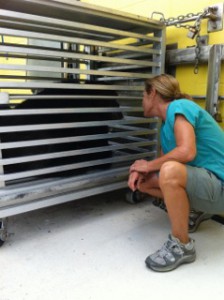
them let me comfort them in that confusing and unsettling time between sedation and consciousness, possibly because they have known me for over a decade. For those chimps that need more time in the security of the smaller box, our favorite thing to do is drive them over to the picnic area where the staff eat their lunch.
We roll the chimp out to be near the lunch table. The chimps and the staff LOVE it! I think all the personal attention given to them, along with the bustling activity and change of scenery fascinates the chimps. At times they visit the enrichment area and watch the staff prepare enrichment.. Finally, when they are fully recovered, we take them back to their families where there is always a wonderful and loud pant hoot of welcome home!
On death and dying
August, 2014
I’m sure I speak for all the people here at Save the Chimps when I say caring for chimpanzees is an amazing honor. Each day brings surprises, challenges and a lot of satisfaction and I wouldn’t want to be anywhere else. But, as the song goes, “into every life a little rain must fall.” In our case, sometimes it’s a deluge.
We’ve had to say goodbye to some wonderful friends over the years; chimps like Dana, Carlos, Tanya, Thoto, Ron and just recently Jack, Scotty, Roman, and Spock. These four chimpanzees were the most charismatic and gentle souls I have ever known. At Present, 12% of our residents are 40 years or older and in chimp years, that is pretty old. Unfortunately, we know that there are many more goodbyes to be said.
So what actually happens at Save The Chimps when one of our chimps nears death after a protracted illness or an acute medical condition? Well, to be honest, we spoil the hell out of them, even more than we normally do. The first area we concentrate on is food; sick chimps, like sick people, tend to lose their appetites. We provide a plethora of options hoping they will enjoy the grapes, pasta, beans or strawberries, knowing more often than not that same item will be passed over the next day. Sometimes only a raw onion will do!
The next order of business is to make sure the group isn’t causing any undo stress on the chimpanzee that is sick. We try and provide constant access to the island if that is what they prefer, or keep them inside with a select group of friends if that makes them more comfortable. One of the most difficult decisions of all is when and if we need to intervene to help them die with dignity through euthanasia.
I have no idea how it happens, but an eerie silence descends over the sanctuary when a chimpanzee dies. The chimp family is allowed as much time as they like to say goodbye. I believe anyone who doesn’t think animals grieve h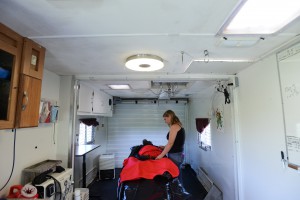 as not been observant enough to notice. Often we see one or two chimps taking more time than others to stroke the body or hold the hand of the deceased. Finally the staff says goodbye and although there are many tears, there is comfort in knowing that we have made their lives better. Lastly, the ashes are spread on their island and we acknowledge that they may be gone, but will never be forgotten. I miss them all…….
as not been observant enough to notice. Often we see one or two chimps taking more time than others to stroke the body or hold the hand of the deceased. Finally the staff says goodbye and although there are many tears, there is comfort in knowing that we have made their lives better. Lastly, the ashes are spread on their island and we acknowledge that they may be gone, but will never be forgotten. I miss them all…….
A day in the life of the vets…
June, 2014
There is no “typical” day for a Save the Chimps veterinarian. Every day is unique and as hard as we may try to stick to a routine or schedule, the chimpanzees often have their own ideas. 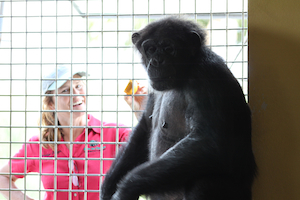 Mornings begin with daily rounds. We visit every building, one at a time, to look at the chimps and talk to the caregivers. Feeding time is when all the chimps are inside and when we can see injuries, illness or abnormal behaviors. If everyone seems healthy, it is a time for the vets to go out and play! It is important that the chimps don’t just see us as the people who sedate them. We want to be trusted friends- it allows us to observe and examine them more closely — and without undue stress. And observe we do! Some of our chimps love the attention and will gladly point out any scratch or scrape as if to say, “Fix it, Doc!” While others require time, patience, and special treats. It is not unusual to see the vets practically standing on their heads with a flashlight while handing a chimp a treat so they can look at a wound.
Mornings begin with daily rounds. We visit every building, one at a time, to look at the chimps and talk to the caregivers. Feeding time is when all the chimps are inside and when we can see injuries, illness or abnormal behaviors. If everyone seems healthy, it is a time for the vets to go out and play! It is important that the chimps don’t just see us as the people who sedate them. We want to be trusted friends- it allows us to observe and examine them more closely — and without undue stress. And observe we do! Some of our chimps love the attention and will gladly point out any scratch or scrape as if to say, “Fix it, Doc!” While others require time, patience, and special treats. It is not unusual to see the vets practically standing on their heads with a flashlight while handing a chimp a treat so they can look at a wound. 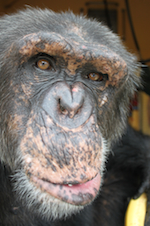 There are some things vet school doesn’t teach you. Rebel, for example, had an injury on the bottom of his foot. Day after day I would have to sit outside the cage and watch and wait until he sat in just the right position that I could see it. He didn’t want grapes, didn’t want juice, and definitely didn’t want to play with me. Finally, after several days of this, one day he looked right at me, walked over and stuck his injured foot up against the mesh, then waved me away. I’m pretty sure he was as tired of the daily charade as I was. As we go on rounds we alter medications, recommend other treatments (keeping a chimp inside, scheduling a work-up, spraying a wound), and visit our chimp friends. The rest of the day includes updating charts, researching treatments, and administrative activities peppered with calls about a decreased appetite or swollen digit.
There are some things vet school doesn’t teach you. Rebel, for example, had an injury on the bottom of his foot. Day after day I would have to sit outside the cage and watch and wait until he sat in just the right position that I could see it. He didn’t want grapes, didn’t want juice, and definitely didn’t want to play with me. Finally, after several days of this, one day he looked right at me, walked over and stuck his injured foot up against the mesh, then waved me away. I’m pretty sure he was as tired of the daily charade as I was. As we go on rounds we alter medications, recommend other treatments (keeping a chimp inside, scheduling a work-up, spraying a wound), and visit our chimp friends. The rest of the day includes updating charts, researching treatments, and administrative activities peppered with calls about a decreased appetite or swollen digit.
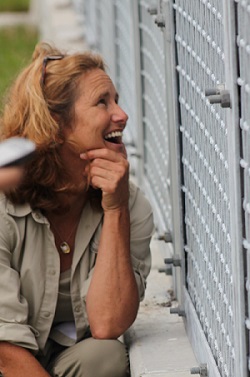 We spend a lot of our time making sure we are doing everything we can to provide for our chimps. We schedule work-ups, make anesthetic plans, network with other professionals, review medications, answer questions, and recheck ongoing cases. Some days we spend on the phone and computer, others we spend zipping around the sanctuary. If a chimp is sick, we’ll likely be found sitting beside them with a bin of special foods, coaxing them to eat, or grooming them gently with a tickle stick to reassure them. When J.R. had a cold we spent our afternoons with him and a nebulizer. A day with the vets isn’t always fun. Sometimes we have to perform a sedation or lock a chimp inside so he or she can heal, which the chimps don’t like. However, we’re lucky enough to have a healthy, slow day, we head back out into the sanctuary and play.
We spend a lot of our time making sure we are doing everything we can to provide for our chimps. We schedule work-ups, make anesthetic plans, network with other professionals, review medications, answer questions, and recheck ongoing cases. Some days we spend on the phone and computer, others we spend zipping around the sanctuary. If a chimp is sick, we’ll likely be found sitting beside them with a bin of special foods, coaxing them to eat, or grooming them gently with a tickle stick to reassure them. When J.R. had a cold we spent our afternoons with him and a nebulizer. A day with the vets isn’t always fun. Sometimes we have to perform a sedation or lock a chimp inside so he or she can heal, which the chimps don’t like. However, we’re lucky enough to have a healthy, slow day, we head back out into the sanctuary and play.
Giving Meds
April, 2014
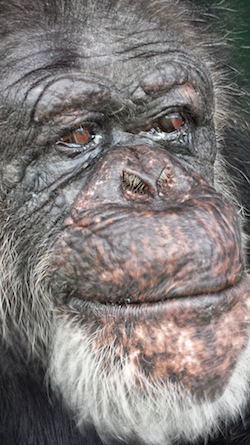 I was sitting at my desk this afternoon and I heard someone ask Janie, a caregiver, if she thought Roman, would like some oatmeal. She replied, “Only if it isn’t too moist, he hates it moist. “ I chuckled as I thought about how much love and attention to detail goes into caring for our wonderful 260 chimpanzees.
I was sitting at my desk this afternoon and I heard someone ask Janie, a caregiver, if she thought Roman, would like some oatmeal. She replied, “Only if it isn’t too moist, he hates it moist. “ I chuckled as I thought about how much love and attention to detail goes into caring for our wonderful 260 chimpanzees.
People often ask me how we get medicine into the chimps and I usually give a simple answer; oh they take it in juice or sometimes we mix it in food. What really happens behind the scenes is much more complicated and labor intensive. The daily medications for such ailments as arthritis, hypertension and inflammatory bowel disease are more often than not accepted when mixed in a small amount of juice. The difficult part comes with our finicky or suspicious chimps. I suspect they are slightly wary from their previous years in research.
The most challenging is an acutely sick chimp. What do we do then? Well, every trick in the book comes into play. Meds are mixed in soy protein drinks, yogurt, applesauce, frozen bananas, nutella, PB and J, honey, jams, and even an occasional “sea breeze” with fresh squeezed orange juice and cranberry juice. Other options include homemade stuffing, mashed sweet potatoes or for dear Plum, a honey mixture spread on whole wheat bread – no crusts please!
But it doesn’t stop there. The next step is figuring out if they want a bottle or a cup and what kind of bottle or cup, straw or no straw? Do we have to open the juice container in front of them or do we mix the meds into a juice box and present it as though it hasn’t been tampered with? Finally, who is giving it to them? Do they want their regular caregiver or do they prefer someone else they are fond of who happily stops by. It takes a lot of people working together to make sure the chimps stay healthy. Believe me there is a collective cheer from all when we hear one of more challenging chimps has accepted his meds!


